Last week, I broke down one of the most ironic US bills in history: the Inflation Reduction Act.
I showed you why it would actually end up leading to higher prices (if you missed it, you can read it here).
But why would the US government come up with such an inflationary bill to combat inflation?
Today, we reveal the main puppeteer pulling the strings on lawmakers to push the bill through and why he did it.
After you finish reading this letter, there will be no question about what this bill was intended for.
Let’s get into it.
Follow the Money
Because every Republican opposed the Inflation Reduction Act and Democrats hold the thinnest majority in the Senate, the bill’s passing hinged entirely on the Democrats’ unanimous vote.
One would think this was a sure bet. But one democrat stood in the way: Democratic Senator Joe Manchin. He had already derailed the first two iterations of the bill.
Last year, Democrats were inches from passing Biden’s originally-envisioned Build Back Better Act, pledging to spend a mind-blowing $3.5 trillion on green energy and social programs.
But at the last moment, Manchin backed out of it.
Then, last December, Democrats conceded and put together a smaller, $2 trillion package. Yet despite Manchin’s pledge to vote for a smaller bill, he vetoed it again.
Democrats gave it one last shot this year to break the impasse before the midterms. But unfortunately, it wasn’t looking good because Manchin called the bill “dead” from the get-go over – you guessed it – fear of inflation.
So in came the heavy artillery.
People familiar with the matter told Politico that some 20 of the most influential leaders from green energy companies banded together to change Manchin’s mind.
Via Politico:
“Clean energy manufacturing companies with plans to set up shop in Manchin’s state helped orchestrate the 13-day effort to change his mind, more than 20 people involved in the effort told POLITICO…
Power generation companies that had multiple meetings with Manchin over the last 18 months pressed for a deal as well, with Duke Energy and Constellation Energy making the case for the clean energy package in the days after Manchin appeared to walk away from the energy and climate measures.
A senior executive with a clean power company said his firm communicated with Manchin, Schumer and Senate Finance Chair Ron Wyden (D-Ore.) in the past two weeks “softly reminding them” that “tens of billions of dollars in investment are at stake here.”
But that’s not all.
Spearheading this lobbying is one of the most prominent and influential figures of our time. He played a huge role in the pandemic and the encouragement of vaccines – just BEFORE COVID broke out. He became one of the largest farmland owners BEFORE the food supply shortages.
He is none other than the famous, or infamous, Bill Gates.
And he personally took on the task of winning Manchin over.
After Manchin announced that he would not support Build Back Better last December, Gates had him over for dinner.
Then, a month before the vote, on July 7, he again met with him at the Sun Valley media conference in Idaho.
“We had a talk about what was missing, what needed to be done,” Gates told Bloomberg in a recent interview. “And then after that, it was a lot of phone calls.”
Gates also reportedly gave a pep talk to Senate Majority Leader Chuck Schumer, who was meant to hold out a Democrat majority for the vote and ensure Manchin didn’t have second thoughts.
In the end, Gates succeeded.
Manchin finally caved and voted in favor of the bill.
Gates’s Green Energy Funds
You may be thinking: why does Bill Gates care about this bill?
From vaccine activist to now a fierce climate activist, Gates is running the biggest “public-private” fund targeted at green energy called Breakthrough Energy Catalyst.
In short, it’s a coalition of billionaires that hands out private and public capital to green energy companies.
Here’s how the model works in a nutshell.
Via Breakthrough Energy:
“At COP26 in Glasgow, European Commission President Ursula von der Leyen and Bill Gates, the Founder of Breakthrough Energy, together with European Investment Bank President, Werner Hoyer, formalised a partnership to mobilise public and private funding in emerging climate technology projects…
To operationalise this collaboration, Breakthrough Energy Catalyst has launched this RFP to identify and select emerging climate technology projects based in the European Union for project-level financing. Projects selected by Catalyst from this RFP will be considered by the European Commission and European Investment Bank to receive blended financing under the InvestEU Programme.“
What a perfect setup to take trillions of dollars from governments worldwide* to fight the climate change “emergency.” An emergency that over 1100 scientists and professionals have now signed up to deny.
(*One could argue this is a similar playbook to how the COVID vaccines were rolled out.)
But of course, without government funding (otherwise known as your money), none of these new highly risky climate change technologies would pan out.
Via ZeroHedge:
“Critical for all these climate technologies is to get the costs down and to be able to scale them up to a pretty gigantic level,” Mr. Gates said. “You’ll never get that scale up unless the government’s coming in with the right policies, and the right policy is exactly what’s in that infrastructure bill.”
Gates also insisted that these “demonstration projects” are critical to making new technologies work.
The interview featured a subtle threat: if Congress doesn’t approve the infrastructure package (with the climate funding attached), Gates will take his “Breakthrough” funding elsewhere, likely to Europe and Asia.”
It seems Bill Gates is about building even more wealth using taxpayer dollars.
Or perhaps he has good intentions and truly believes in climate change. But does spending billions – now trillions – of taxpayer dollars in private sector ventures pan out often?
Almost never.
There’s no better example than Obama’s “green deal” that committed $80 billion to renewable energy companies from 2008 to 2011.
Remember Solyndra—a solar panel maker that gobbled up $500 million in loans and grants from the Obama Administration and quickly went under with all of it?
Oh, and let’s not forget these government-subsidized green energy companies who filed for bankruptcy:
- Abound Solar – $401 million taxpayer dollars wasted
- Calisolar – $280 million taxpayer dollars wasted
- Fisker Automotive – $193 million taxpayer dollars wasted
- A123 Systems – $132 million taxpayer dollars wasted
Imagine if all of this money was used to help lift cities out of poverty by building affordable homes, childcare, and schools – you know, the real emergencies.
But nope, as we mentioned last week, 80% of the $430 billion spending will go to green energy.
Let me paint a picture of how ludicrous this is.
The average price of a typical home in the US, according to Zillow, is $355,852. If we took the “green energy” funding of $344 billion (80% of $430 billion) and simply built homes, we could build 966,694 homes.
That’s enough homes to house nearly 1 million families.
But nope, it’s all going to testing green energy.
So is it really about philanthropy?
Activist Investor in a Philanthropist Disguise?
Any person who ran a multi-billion dollar public company is smart enough to understand investor behavior. And that delegitimizing fossil fuel will choke off capital to legacy energy companies.
That, in turn, will destroy the energy supply and counterproductively make fossil fuels more attractive.
It’s like stock manipulation at its finest.
And get this…Bill Gates has been doing just that.
Instead of supporting a natural transition—which would achieve our green energy targets without stoking inflation—he’s using his influence to fear-monger investors into dumping energy companies:
In the meantime, he’s quietly cashing in on fossil fuels himself.
While he’s shunned most of his direct holdings in oil and gas companies for display (he still owns ~$100 million in the likes of Exxon Mobil Corp and Chevron Corp), he’s making a ton of oil profits indirectly.
For example, the Gates Foundation Trust shoved half of its funds ($11 billion) into his friend Warrant Buffet’s holding company, Berkshire Hathaway—which has been one of the most vocal oil proponents lately.
“By the end of 2021, more than 1,400 institutions (pdf), with $39.2 trillion in assets under management, had committed to selling some or all of their stakes in fossil fuels. Buffet, though, is doing the opposite. His investment company, Berkshire Hathaway, became Chevron’s fourth-largest equity stakeholder in April, the value of its investment jumping to $25.9 billion, from $4.5 billion in Dec. 2021.
Berkshire has simultaneously been buying up shares in Occidental Petroleum. After first buying $10 billion in preferred Occidental shares in 2019, Buffett repeatedly topped up his stake this year, becoming the company’s largest shareholder with nearly 19% of it. And according to at least one analyst, Berkshire may want to purchase all of Occidental.”
The Gates Foundation also owns $1.54 billion worth of shares in the Canadian National Railway Company – a major oil transporter for Canada’s oil sands—the world’s biggest and most carbon-intensive oil deposits.
If Gates was as diehard a climate activist as his carefully crafted public image has sold the mainstream media, there’s no way he would place a few percentage points of marginal returns before his cause – especially since he’s already one of the richest people on earth.
So who’s not putting their money where their mouth is?
We Are Environmentalists Capitalists.
As I wrote last week, our energy policy is putting the cart before the horse.
Instead of choking fossil fuel energy, policymakers should subsidize it (or at the least deregulate) so we can keep our costs down as we transition to alternatives – especially during a time of high inflation.
Even Elon Musk, who’s more devoted to green energy than anyone, thinks that’s the right way to go. “Hate to say it, but we need to increase oil & gas output immediately,” he tweeted last month.
Meanwhile, leftists are continuing the eradication of the energy sector as the world approaches a historic energy crunch.
Take California, who recently voted to ban gas-powered cars in the state by 2035.
The irony?
Less than a week later, Californians were told not to charge their cars, not to use AC below 78 degrees Fahrenheit (26c degrees Celsius), and not to use large appliances – all because their energy grid doesn’t have enough energy.
Via California ISO:
“…The power grid operator expects to call on Californians for voluntary energy conservation via Flex alerts over the long weekend.
During a Flex Alert, consumers are urged to reduce energy use from 4-9 p.m. when the system is most stressed because demand for electricity remains high and there is less solar energy available. The top three conservation actions are to set thermostats to 78 degrees or higher, avoid using large appliances and charging electric vehicles, and turn off unnecessary lights. Lowering electricity use during that time will ease strain on the system, and prevent more drastic measures, including rotating power outages.”
Think it’s only California?
Think again.
A company in Colorado even wirelessly shut off access to customer’s thermostats.
Via Denver Post:
“On Tuesday, as temperatures rose into the lower 90s in the metro area, Xcel took complete control and locked thermostats because of an “emergency situation.
…More than 22,000 Xcel AC Rewards customers were locked out of their smart thermostats for hours on Tuesday, according to Denver7. On social media, dozens of Xcel customers complained about the experience, with some reporting home temperatures as high as 88 degrees.
…The emergency stemmed from an unexpected energy outage in Pueblo combined with local hot weather and heavy air conditioning use.”
Go figure.
And for what?
So politicians can pass their greenwashing agenda that will explode deficits, stoke inflation, and siphon billions of dollars into the pockets of the ultra-wealthy?
Now imagine if everyone had electric vehicles…
And then imagine a world where, at anytime, the government or corporations can shut off your energy and then prevent you from travelling with your all electric car.
As Larry Fink, CEO of BlackRock, a major investor in Gate’s Breakthrough Energy fund, admitted, “We focus on sustainability not because we’re environmentalists, but because we are capitalists and fiduciaries to our clients.”
So, you see, this isn’t about Left vs. Right, Democrat vs. Republican, or Liberal vs. Conservative.
It’s about money.
Energy is a required cost of almost all outputs. From food to consumer products, everything requires energy – and most of our energy comes from oil and gas. So the next time you complain about higher prices – not just the price at the pump – think about whose behind it and what their real intentions are.
After reading this, do you still buy all this federal greenwashing?
Seek the truth and be prepared,
Carlise Kane


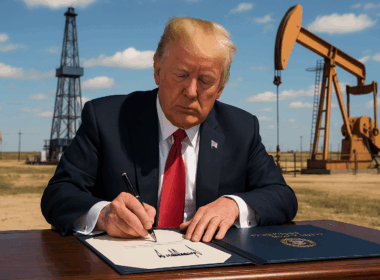
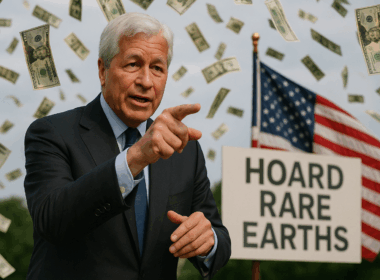



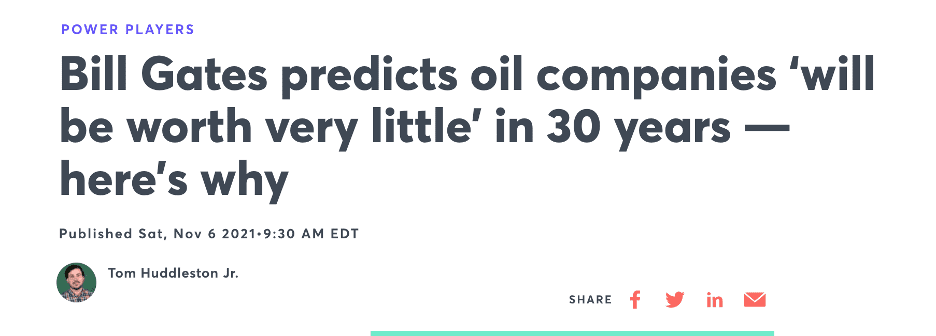


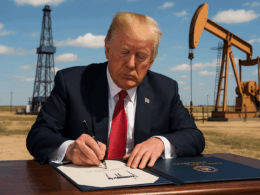
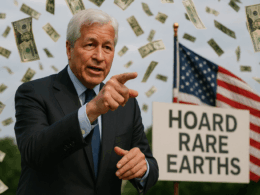


I havent bought into the green energy bull from the beginning, what are they going to use to lubricate all those moving parts , yea grease from oil refineries, idiots have gone to full blown retards.
It’s absolutely absurd to have a country’s officials change their opinions, votes because of the amount of Money being pressured against them till they cave and agree with what they originally felt was wrong. Manchin Did exactly that. The Inflation Reduction Act is one of the biggest Fake Acts created by the Dems to be able to spend to reach any of their goals.
Energy is the lifeblood of humanity. Climate has been changing ever since there has been a climate. Human activity has some change on climate, but how much.
We came out of the ice age without industrial revolution.
I don’t think that humans should pollute our water and air.
The assumption that economics is the science of scarcity is wrong. Economics is the science of wasting. According to the French writer and philosopher Georges Bataille (1897-1962).
Wars, catastrophes, epidemics, mediocre political leaders etc. Wasting makes the world go round.
I recall when Bill Gates came upon the scene back in the late 1980’s. Back then he sold computers didn’t he?
When did he get into the grease and manure businesses? Wow, he is quite the businessman isn’t he!
We need some green energy over time but oil and gas production in our country is very clean and abundant. We can supply our needs and also raise money by selling to our friends. Last winter in Texas proved that the windmills in North & in South Texas couldn’t supply our basic power needs at all. People are foolish to jump from tall buildings without a safe parachute.
blah blah blah ….can you start giving us some disruptive stock picks to prosper from all these scenarios ????
This is no different than the stock market manipulation taking place everyday before our eyes by big money players / market participants, while stock exchanges are turning a blind eye to so they too can make alot more $’s. All they have to do is put in restrictions on # of shares bought per stock per account to have a level playing field. The rich will always have there way especially when they can bribe politicians. Is this really democracy or totalitarianism country?
From Canada , our PM says let’s look ahead to 2050 we should be working towards Hydrogen liquid hydrogen Our pipeline was shut down by uncle Joe the first week he was in power he didn’t want crew Oil from the tar sands going across the United States didn’t necessarily have to be crude oil from the tires and it could’ve very easily been liquid natural gas what is the cleanest burning fossil fuels that we know today who is Canadians have an excess amount of natural gas we could liquify put it in a pipeline and send it anywhere these politicians are only making statements to bring votes to there continuous rain that is full of fantasy expectations wait until Buddy has an electric car and watch the price of electricity go up it’s a joke people aren’t concerned about the environment hearing about their pocketbook even the people buying electric cars thinking they’re doing a better job and cleaning the environment where is the electricity come from it’s going to be more and more costly liquid natural gas which is not talked about should be a prime source of energy for the western world thanks for reading my quote on my eight employee or my bald or whatever you wanna call it
A slow transition to fossil free energy may work if the the world’s population radically reversed course and we all went backward to much lower energy consumption. NOT LIKELY!!!!!
What hope do we have when the giants of capitalism take over for their own benefit. It seems that no one ever represents the people . That is why Donald Trump”s message resonates with so many. He pursued practical energy policy which if allowed could morph into greener phases naturally without government decrees.
You want to continue down this path, continue to vote those Democrat’s into office.
Tired of seeing the United States destroyed then vote Republican.
Donald Trump was a thorn to Bill Gates and his agenda; he was going to lose the election one way or another. Bidens and Clintons should be behind bars, anyone that thinks different is an idiot!!
I agree.
Animals, fish and plants migrating all over the planet including my garden – humans soon to follow.
It does not matter what Bill’s motivation is to support innovative green tech – we need it fast and it will save Trillions long term. Yes – there will be some false starts but we only need a few successes. Look at some of your innovators – Ambri, Heliogen, Energy Vault, EnerVenue, Musk, to just name a few. These companies can help lead the world to a better future. Wake up USA. Do your own research and give your kids a better future.
If you look up about the scientists denying climate emergency it seems fairly shady. Some of the names are deceased as well many names are oil and gas lobbyists. https://www.euronews.com/my-europe/2022/09/16/fact-check-did-1200-climate-experts-sign-declaration-denying-climate-emergency
Although I do agree greenwashing is not the way to go, we need oil and gas to help us smoothly transition.
I’ve been reading equidia for some time now and I enjoy the reads but am skeptical about their intentions. The front page states they are one of the best performing newsletters but no scorecard of any sort to back that up. And best of all it’s free? So what are they gaining?
I have a hard time seeing who is actually behind this not sure if this info is available on their Facebook but can’t really find any author bios on the site which I think it should at least give some sort of indication of who’s writing this.
On the flip side I have tried their recommendation using the hapbee and that stuff actually works so don’t know how I feel.
Enjoy the reads to get a different perspective but can’t take it too seriously because of the stated reasons above. I may be wrong though let me know !!